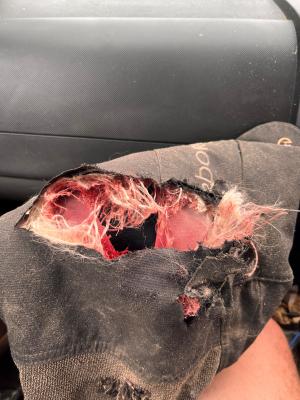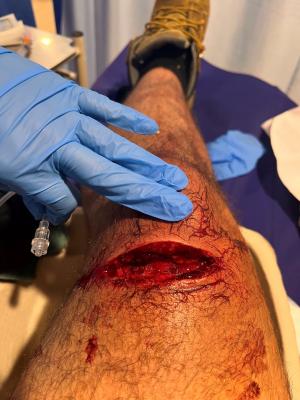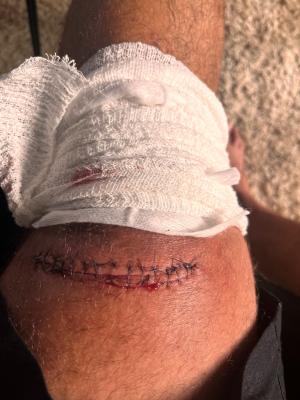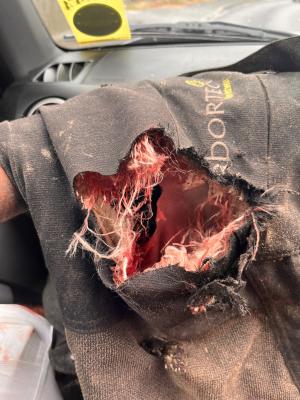Types of Chainsaw Trousers & a Safety Notification
With the risk of telling people what they may already know, we would like to remind everyone of the options available regarding chainsaw trousers. We have recently been told of an injury caused when using a chainsaw, to one of our valued local customers, who is an experienced tree surgeon of many years. Luckily, his chainsaw trousers slowed the saw enough to avoid a major injury, however this was an extremely close call. This has brought to light a possible issue about knowledge within the industry of chainsaw trousers available, & chain speeds of modern chainsaws. Even among experienced operators, it is always worth knowing the facts & figures behind the tools in use.
***WARNING***
***THERE ARE SOME GRAPHIC IMAGES USED FURTHER DOWN IN THIS ARTICLE, PLEASE BE AWARE OF THIS & AVOID IF YOU DO NOT WANT TO SEE THE INJURY***
*THERE WILL BE ANOTHER WARNING IMMEDIATELY BEFORE THE IMAGES***
Please also note that we have full authorisation for use of the images & details enclosed in this article, & the article has been published after a conversation with the customer. This has been done with the hope of imparting crucial safety knowledge within the industry.

(The damage caused by a STIHL MS500i to a pair of chainsaw trousers)
Classes of Chain Speed
Back in the days when chainsaws weighed the same as a small car, had little to no anti-vibration & gave more fumes than an industrial chimney, a standard was drawn up regarding protective trousers & their chain speeds. The classes have not changed since, & nor have the corresponding chain speeds.
EN ISO 113393 (Garments that comply with the EN ISO 11393 standard provide protection against hand-held chainsaws) replaced EN 381 in 2020, with the main differences being in testing of garments & small changes to "Type B" chainsaw trousers (Not sold in the UK). With regards to chain speeds, these are:
- Class 0 : 16 m/s (Usually found in gloves)
- Class 1 : 20 m/s (Industry standard for chainsaw trousers)
- Class 2 : 24 m/s
- Class 3 : 28 m/s
What has changed is the speed of handheld chainsaws, like the Husqvarna 550XP or the STIHL MS500i for example. Both of these hugely popular chainsaws can travel in excess of 25m per second. Industry standard for chainsaw trousers has typically been class 1 (20 m/s). These are at the lighter, cooler end of chainsaw trousers, hence why they are the most popular. Class 2 & Class 3 trousers offer higher protection but are thicker & heavier to wear. Class 2 & 3 protection is more often found in chainsaw boots, with the idea being that the foot is closer to the end of a chainsaw bar, so may require higher protection if an accident occurs.
Some of our customers are already insisting on Class 2 (24 m/s) or Class 3 (28 m/s) chainsaw trousers. If you would like to discuss ordering Class 2 or Class 3 chainsaw trousers please get in touch with us HERE.
To browse our range of chainsaw trousers please click HERE
What caused the injury?
Without going into too much detail, the injury to our local customer was caused when using a STIHL MS500i chainsaw. When running at full speed, a 500i runs well above standard class 1 chainsaw trousers speed of 20 m/s. Our customer was wearing class 1 trousers at the time of the accident, and luckily natural instinct kicked in quickly and he let off the throttle as the incident occurred. The class 1 trousers did not prevent injury, but combined with good reactions they did prevent a serious, life-altering injury, & instead left the user with a cut that was quickly and efficiently dealt with medically. This allowed him to be back to work quickly. However, this could've gone very differently & he is lucky that it only caused a flesh injury, without going any deeper.
After some conversations with colleagues, it came to light that perhaps not everyone working with chainsaws is aware of the speeds these machines run at & the classes of protection available. When telling us in-store about the accident a couple of weeks afterwards, our customer therefore wanted to try to get some more knowledge out in the industry, even to experienced users, to try to prevent anything happening in the future that can be avoided with use of correct PPE.
(WARNING ***GRAPHIC IMAGES BELOW*** PLEASE AVOID THE IF YOU DO NOT WANT TO SEE THE INJURY).



(First: An image of the cut at the hospital. Second: An image of the cut once stitched. Third: An image of the hole caused in the chainsaw trousers)
We also sell a full range of arborist-certified first aid equipment, for prevention of major blood loss if an accident happens. Please click here to shop.
What are the different types of chainsaw trousers?
The difference between Type A and Type C chainsaw trousers is the area of the leg that is protected. Type A trousers only protect the front of the leg, while Type C trousers protect the entire leg.
Type A trousers are typically used by ground workers who are not at risk of chainsaw kickback from the rear. Type C trousers are typically used by arborists and other workers who are at risk of chainsaw kickback from all sides.
How Chainsaw Trousers Work
Chainsaw trousers work by using a combination of materials and design features to stop the chainsaw chain from cutting through the trousers. The most common material used in chainsaw trousers is aramid, which is a strong, lightweight fibre that is resistant to cuts and abrasions. Aramid fibres are often woven into a fabric that is then sewn into the front of the trousers.
Another material that is sometimes used in chainsaw trousers is dyneema. Dyneema is a type of ultra-high molecular weight polyethylene (UHMWPE) that is even stronger than aramid. Dyneema fibres are often used in the inner layers of chainsaw trousers to provide additional protection.
In addition to the materials used, the design of chainsaw trousers also plays a role in how they work. The trousers typically have a loose fit to allow the chainsaw chain to pass through without getting caught. They also have a gusseted crotch to allow for freedom of movement.
If a chainsaw chain does come into contact with chainsaw trousers, the cross-hatch aramid or dyneema fibres will catch the chain and slow it down extremely quickly. This will prevent the chain from cutting through the trousers and causing injury to the user. Arbortec Forestwear recently produced a great video detailing how trousers work, which you can see below:
To browse our range of Arbortec Chainsaw Trousers, please click HERE
It is important to choose chainsaw trousers that are the correct class for the type of chainsaw that you will be using. For example, if you will be using a chainsaw with a speed of 24 meters per second, you should choose Class 2 trousers.
In addition to the type of protection and class, there are other factors to consider when choosing chainsaw trousers, such as the fit, comfort, and features. It is important to try on a few different pairs of trousers to find a pair that is comfortable and provides the right amount of protection for your work.
If you would like to discuss ordering chainsaw trousers & would like some help, feel free to pop in-store to see us at our Winchester, SO21 1HF branch, or please get in touch with us HERE.